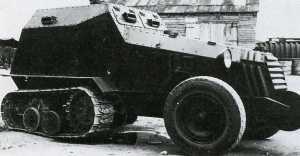Articles >>
Half-track
Category: Term of the day

A half-track is a military vehicle with regular wheels on the front for steering, and caterpillar tracks on the back to propel the vehicle and carry most of the load. The purpose of this combination is to produce a vehicle with the cross-country capabilities of a tank and the handling of a wheeled vehicle. In 1911 the French engineer Adolphe Kégresse converted a number of cars from the personal car park of the Tsar of Russia as half-tracks. His system was named after him: the Kégresse track. From 1916 onward there was a Russian project by the Putilov plant to produce military half-tracks along the same lines using trucks and French track parts.
The primary advantage of a half-track over a full caterpillar-type (or 'crawler') vehicle is the idea of being able to carry its own payload where wheeled vehicles could not go, and where full crawler machines could not traverse with trailers needed to carry a load. Often ballast or 'dead weight' was added to full crawlers for improved traction, where a halftrack simply increases its payload. However the concept originated with the hauling of logs in the Northeastern USA with the Lombard Steam Log Hauler built by Alvin Lombard of Waterville, Maine, from 1899 through 1917, resembling a railroad steam locomotive except with sled steerage or wheels on the front and crawlers turned by drive chains instead of the pitman arm and driver wheels of the railroad locomotive. By 1907, a dog and pony show operator named H.H. Linn abandoned his gas and steam powered four and six wheel drive creations and had Lombard build a motor home/traction engine run by a underslung large four cylinder gasoline engine to travel over the unimproved roads of the day, wheels in front, tracks in rear, the first payload carrying halftrack. By 1909 this was replaced by a smaller machine with two wheels in front and a single track in rear because rural wooden bridges of the day caused problems. Stability issues, coupled with a dispute between Linn and Lombard, resulted in Linn building and putting his own improved civilian halftrack style machines on the market, Lombard attempted to follow but for the most part remained a pulling machine. Linn would later copyright 'HAFTRAK' and 'CATRUK' as trademarks, the latter for a halftrack meant to convert hydraulically from truck to crawler configuration.
In the early days of bulldozer design, Holt tractors had tricycle steering, owing to engineering difficulties with the caterpillars. The Holt tractors went on to become the basis for the Mark I tanks, the Schneider tank, and the German A7V Wotan tank. Also the Holt would be renamed the Caterpillar 60 and launch an industry.
Also not to be discounted are the contributions of 'snowmobile' attachments for automobiles built by White, Snowbird and others, for converting the Fords to halftrack configuration with skis on front and carried the doctor and mail throughout rural America in the winter, as these pioneered the light and flexible traction systems military applications would require, where civilian applications were typically for slow heavy duty use.
There were many experimentations of civilian half-tracks in the 1920s and 1930s. During that period the Citroën company sponsored several scientific expeditions crossing great deserts in North Africa and Central Asia, using their autochenilles.
With the challenging snow and ice landscape of Canada in mind Joseph-Armand Bombardier developed 7 and 12 passenger half-track autoneiges in the 1930s, starting what would become eventually the Bombardier industrial conglomerate. The Bombardier half-tracks had tracks for propulsion in the back and skis for steering in the front. The skis could be replaced by wheels in the summer, but this was not very common.
Half-tracks were used extensively in World War II by all sides, especially the Germans and Americans, but fell out of favor soon after, replaced with fully-tracked or fully-wheeled vehicles. Half-tracks were used primarily as armoured personnel carriers, but also saw duty as mortar carriers, self-propelled anti-aircraft guns, self-propelled anti-tank guns, artillery haulers, armoured fighting vehicles and many other tasks.
Half-tracks were still in use by the Israeli Army until recently, where they were deemed to outperform fully-tracked and fully-wheeled vehicles for non-combat payload tasks such as carrying telecommunication equipment.
One of their main advantages is that they could be driven by anyone able to drive a conventional car or truck, with additional steering automatically being provided by track braking applied from the steering wheel. |
Zavolzhsky Crawler Vehicle Plant
Discuss
